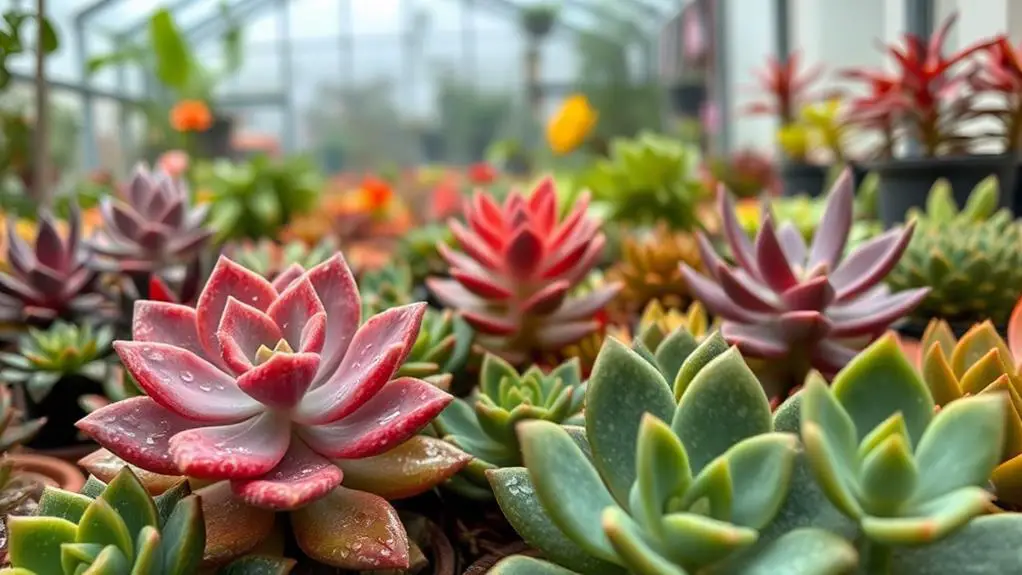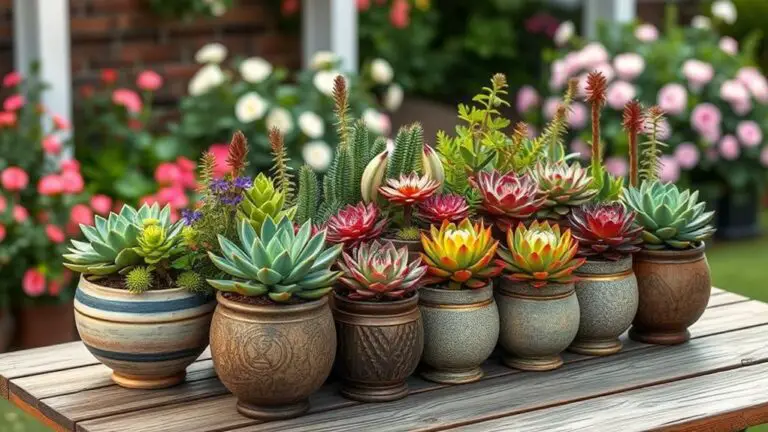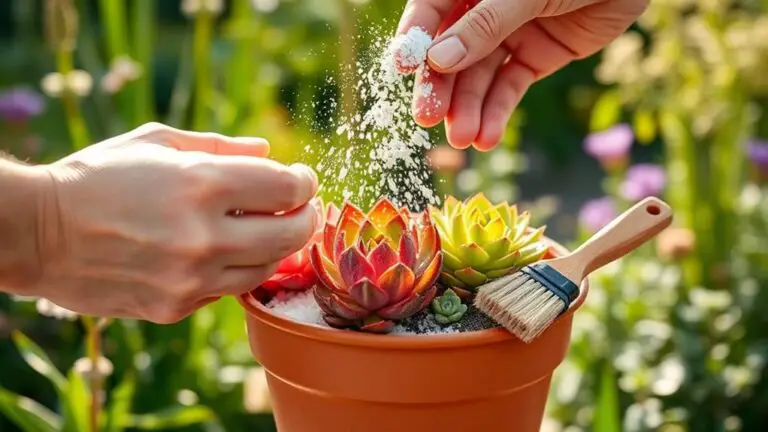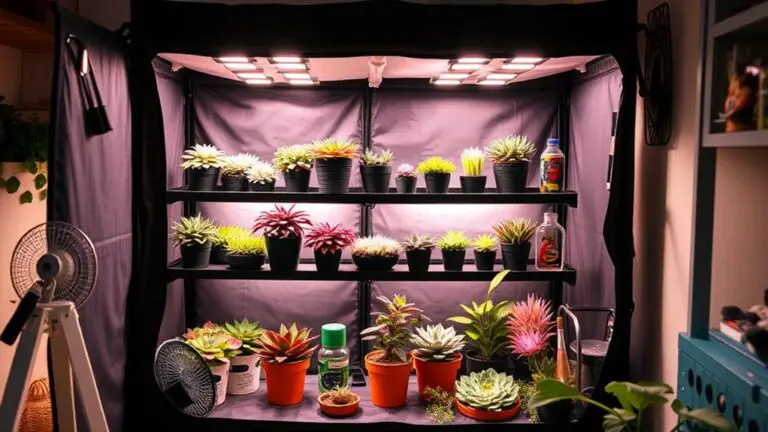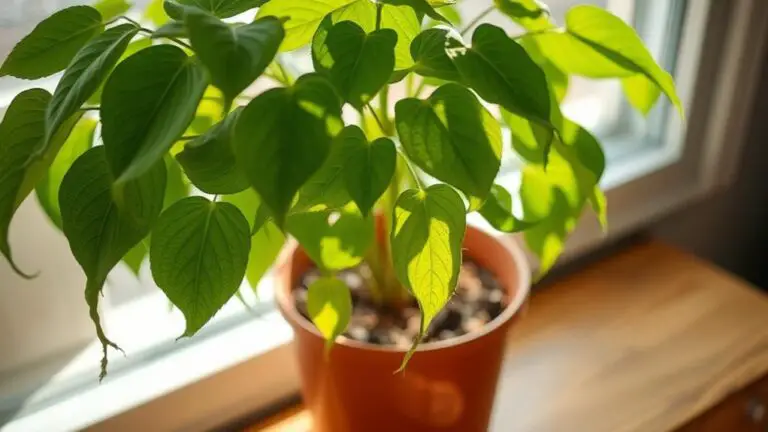How Humidity Affects Succulents: Essential Tips for Thriving Plants
When caring for succulents, you might think sunlight and watering are all you need to focus on, but humidity plays an equally vital role. These resilient plants prefer low humidity environments, typically between 40% and 50%. If the air is too moist, your succulents could face root rot or fungal issues. You'll need to manage your indoor humidity levels, guarantee good air circulation, and adapt your watering habits accordingly. Curious about how to keep your succulents thriving by mastering humidity control? Let's explore some essential tips that can make all the difference.
Understanding Humidity
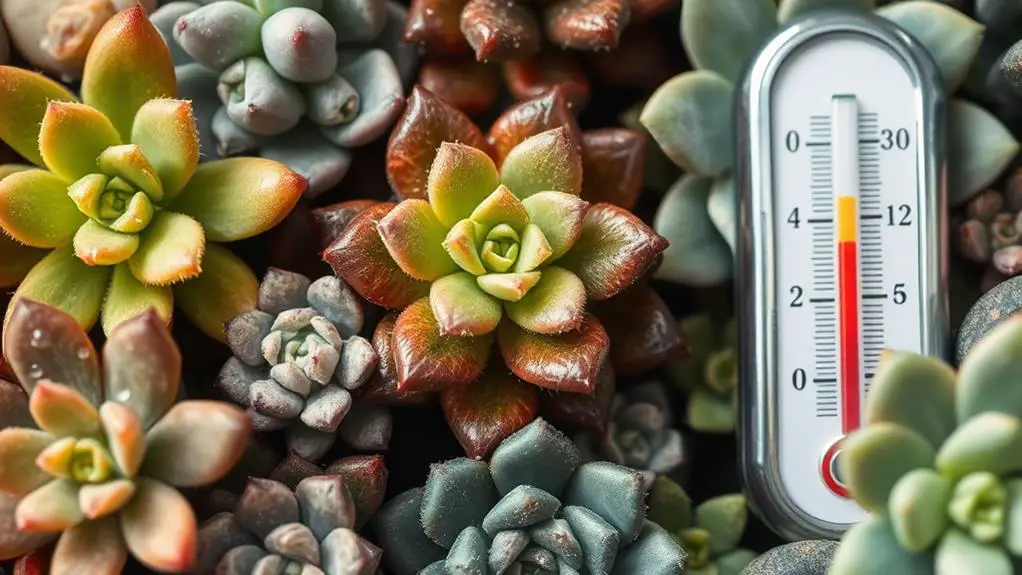
Humidity plays an essential role in the health and growth of your succulents. Humidity refers to the amount of water vapor in the air. For succulents, understanding this concept is critical. These plants thrive best in low humidity environments, typically between 40-50%. This range allows for proper moisture evaporation, which helps prevent overwatering issues that can harm your succulents.
Higher humidity levels can cause moisture to accumulate in the soil. This isn't good for your plants. When the soil stays wet for too long, it can lead to root rot and fungal infections. That's why it's important to use well-draining soil for your succulents. This type of soil helps excess moisture escape quickly, keeping the roots healthy.
Good air circulation is also significant. It helps keep the humidity at the right level and prevents moisture from building up around your plants. You can use a fan or place your succulents in a spot where they get a gentle breeze.
Monitoring humidity levels with a hygrometer can also help you make sure the environment stays ideal for your succulents' best growth.
Ideal Humidity for Succulents
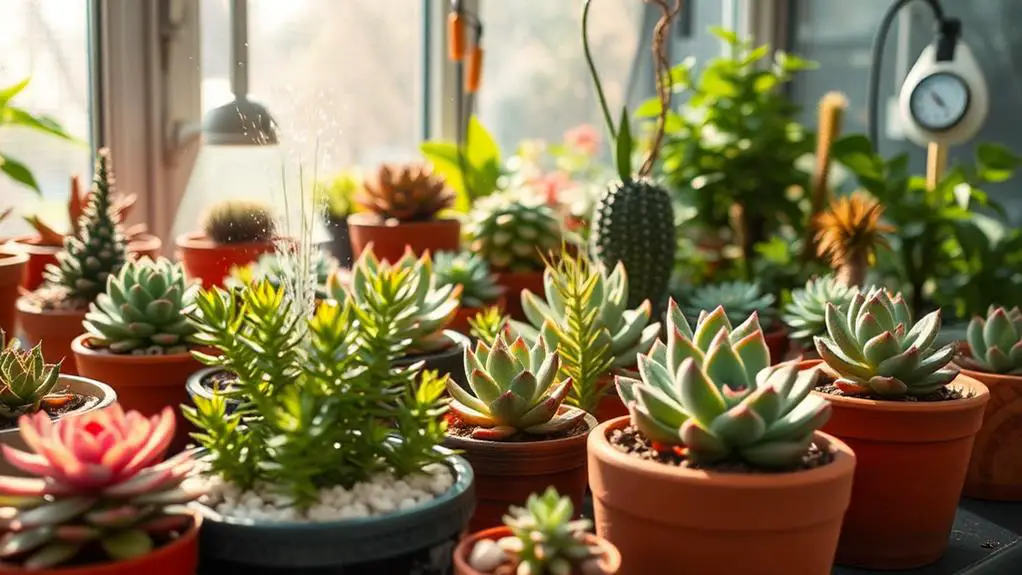
To keep your succulents healthy, aim for a humidity level between 40% and 50%.
High humidity can cause problems like root rot and fungal infections, so managing indoor humidity is key.
Make sure to check the soil moisture regularly and maintain good air circulation around your plants.
Optimal Humidity Range
For succulents to truly flourish, maintaining an ideal humidity range is vital. Succulents thrive best in humidity levels between 40% and 50%. This range supports their growth without causing moisture-related problems.
Low humidity environments are especially good for succulents because they prevent excess moisture in the soil. This, in turn, reduces the risk of root rot and fungal infections.
Even though succulents can handle high humidity for short periods, too much moisture for too long can mimic overwatering symptoms. This can stress the plants and lead to poor health.
So, keeping the humidity within the best range is essential for succulent health. Regularly monitoring the humidity levels in your home can help prevent any negative effects from fluctuating moisture conditions.
Proper air circulation in a room also helps in controlling humidity levels. Good airflow guarantees that your succulents stay in their preferred environment for maximum growth.
Managing Indoor Humidity
Your indoor environment plays an essential role in your succulents' health, and managing humidity levels is key. Succulents thrive best in indoor humidity between 40% and 50%. This range supports their health without causing moisture-related problems. High humidity, typically over 50%, can lead to root rot and fungal infections. To avoid this, you need to regularly check the humidity levels with a hygrometer.
If you find that your indoor humidity is too high, consider using a dehumidifier or air conditioning to lower it. These tools help create a healthier environment for your succulent species. Additionally, improving air circulation with fans can help keep the air moving and promote faster soil drying. This prevents moisture from accumulating around your plants, reducing the risk of root rot.
Here's a simple table to summarize these tips:
| Tip | Benefit |
|---|---|
| Use a hygrometer | Monitor indoor humidity effectively |
| Utilize dehumidifiers | Lower indoor humidity levels |
| Improve air circulation | Helps soil to dry, reduces moisture |
High vs. Low Humidity
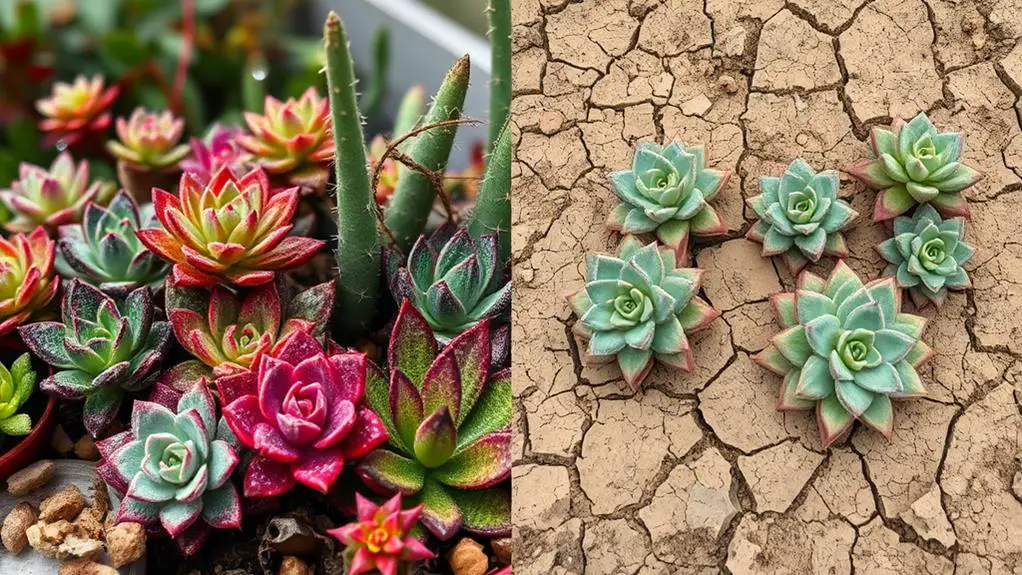
When thinking about humidity levels for your succulents, it's important to know that low humidity below 40% is best for their health.
High humidity, over 50%, can cause problems like root rot and fungal infections, as succulents don't like too much moisture.
To keep your plants happy, try to maintain indoor humidity between 40-50%, and monitor it regularly.
Defining Humidity Levels
Humidity levels play an important role in the health of your succulents, so understanding the difference between high and low humidity is vital. Humidity is the amount of water vapor in the air. For succulents, which are plants that store water, keeping the right humidity is essential.
Low humidity, typically below 40%, is considered ideal for succulent health. It helps to prevent moisture-related issues like root rot and fungal infections.
High humidity, generally above 50%, can be problematic. It causes prolonged moisture retention in the soil, which can lead to root rot. This is why maintaining ideal humidity levels between 40% and 50% is key for your succulents. These levels support healthy growth while reducing the risk of moisture-related problems.
Humidity levels can change throughout the day, especially outdoors. Indoor environments tend to be more stable. To manage this, using a hygrometer can help. It gives you precise readings so you can make better decisions about your plants.
Effects on Succulent Health
Although succulents are known for their resilience, the humidity levels in their environment can greatly impact their health. Low humidity, ideally between 40% and 50%, allows succulents to thrive because it promotes quicker soil drying. This wet-dry cycle is essential for their growth.
In contrast, high humidity can spell trouble. It increases the risk of root rot and fungal infections, mimicking symptoms of overwatering and causing confusion in care.
In high humidity environments, succulents may struggle due to excessive moisture around their roots. Here's how humidity affects their health:
- Root Rot: High humidity can keep the soil too wet, leading to root rot.
- Soil Drying: Low humidity guarantees the soil dries out faster, preventing waterlogging.
- Air Circulation: Good air circulation can help reduce moisture buildup, especially in humid settings.
Succulents have adapted to store water in their leaves, stems, and roots, making them less dependent on air moisture. Consequently, they prefer conditions that prevent excessive humidity.
Making sure proper air circulation can help balance the environment, mitigating the negative effects of high humidity. By understanding these factors, you can create a healthier setting for your succulents.
Managing Indoor Humidity
To create an ideal environment for your succulents, managing indoor humidity is vital. Succulents thrive best when humidity levels are between 40-50%. This range helps prevent root rot and fungal infections, which can harm your plants.
If humidity levels rise above 50%, your succulents might show symptoms of overwatering, like yellowing leaves and stunted growth.
To reduce high humidity, consider using a dehumidifier or air conditioner. These devices effectively lower moisture in the air, creating a more suitable environment for your succulents.
Regular air circulation through fans can also help. By keeping the air moving, you can avoid moisture accumulation around your plants, further protecting them from root rot.
Monitoring your indoor humidity with a hygrometer is a smart move. This handy tool lets you keep track of humidity levels, so you can make adjustments as needed.
Also, using the right succulent potting mix is essential. A well-draining mix guarantees that excess water doesn't stay around the roots for too long.
Effects of High Humidity
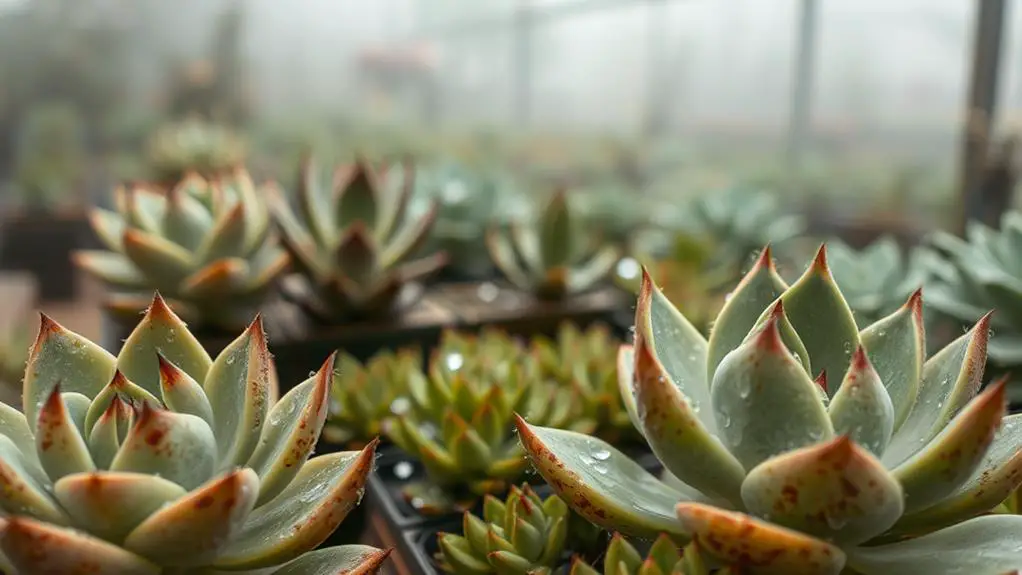
Ever wondered why your succulents seem stressed during humid weather? High humidity levels above 50% can increase the risk of root rot and fungal infections in these plants.
Unlike other houseplants, succulents thrive in low humidity environments. When the air is too moist, it can hinder the evaporation of moisture from the soil, making it difficult for your plants to dry out properly between watering sessions.
Here are a few practical steps to help your succulents cope with high humidity:
- Improve Air Circulation: Using fans and dehumidifiers can help reduce moisture in the air and keep your succulents happy.
- Check Drainage Holes: Confirm your pots have adequate drainage holes to prevent water from pooling at the bottom, which can lead to root rot.
- Monitor Soil Moisture: Regularly check the soil to confirm it's drying out between waterings, and only water when the soil is completely dry.
Preventing Root Rot
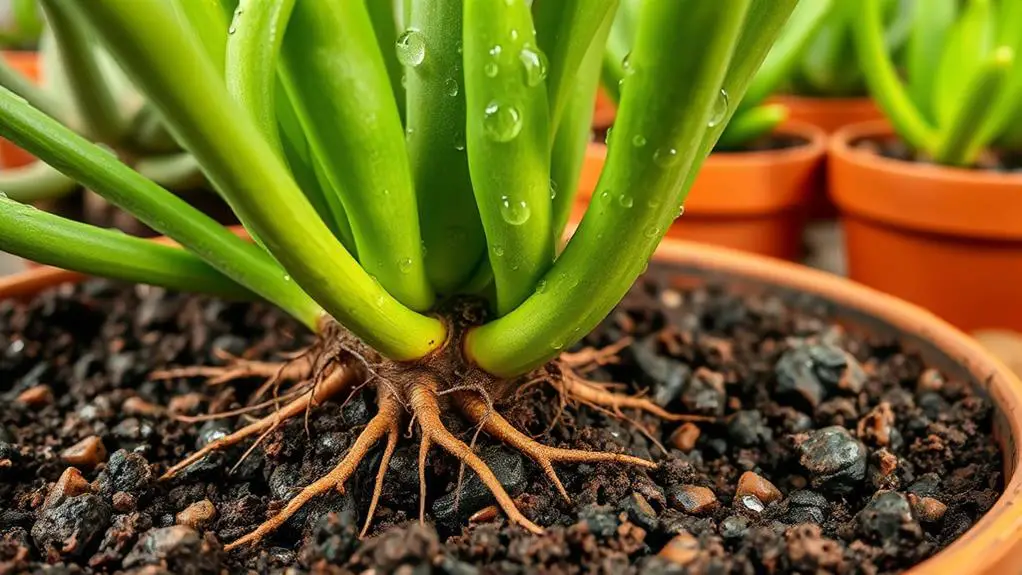
Root rot can be a death sentence for succulents, but you can take proactive steps to prevent it. First, you need to prevent waterlogged conditions by using well-draining soil. A good mix contains one-third organic material and two-thirds mineral material like perlite or coarse sand. This helps excess water to drain away quickly.
Next, make sure your pots have adequate drainage holes. This is vital because even well-draining soil can't do its job if the water has nowhere to go.
When watering your succulents, only do so when the top inch of soil is dry. This wet-dry cycle is essential for keeping root rot at bay.
Keeping an eye on humidity levels is also important. Aim for 40-50% humidity. Higher levels can make the soil retain more moisture, increasing the risk of root rot.
Regularly check the moisture level in your soil and adjust your watering routine accordingly.
Managing Indoor Humidity
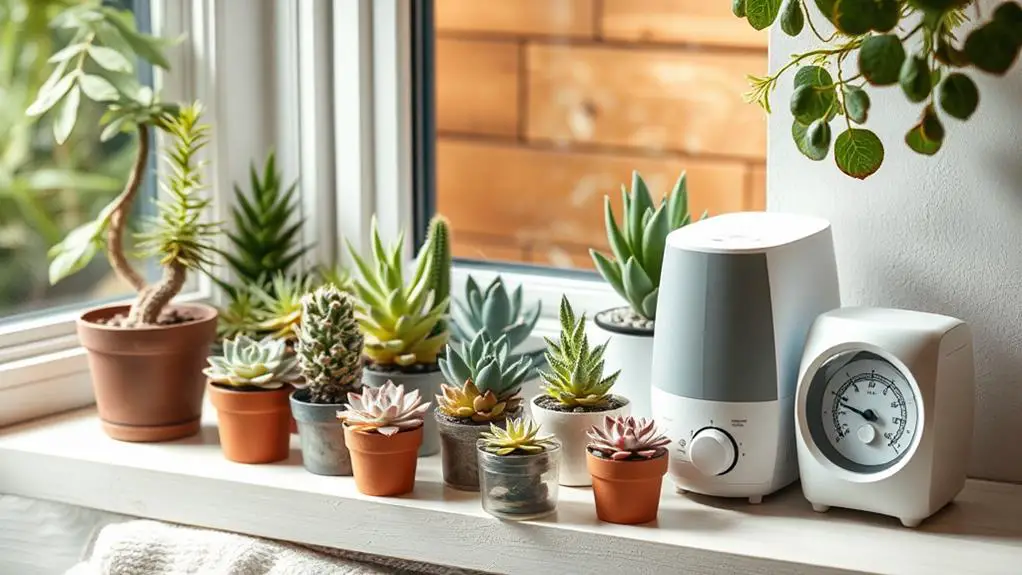
Maintaining the right indoor humidity is essential for the health of your succulents. Aim for indoor humidity levels around 40-50%. This range supports your succulents' health without promoting rot or mold. To achieve this, you'll need to monitor and manage the humidity in your home carefully.
First, consider using dehumidifiers. In naturally humid climates, dehumidifiers can effectively lower indoor humidity, creating a drier environment where your succulents can thrive. These devices are especially useful in keeping the air dry and preventing moisture buildup around your indoor plants.
Second, regularly monitor indoor humidity with a hygrometer. By checking humidity levels often, you can guarantee they remain stable and suitable for succulent care. This simple tool helps you make necessary adjustments to maintain the perfect environment for your plants.
Enhancing Air Circulation
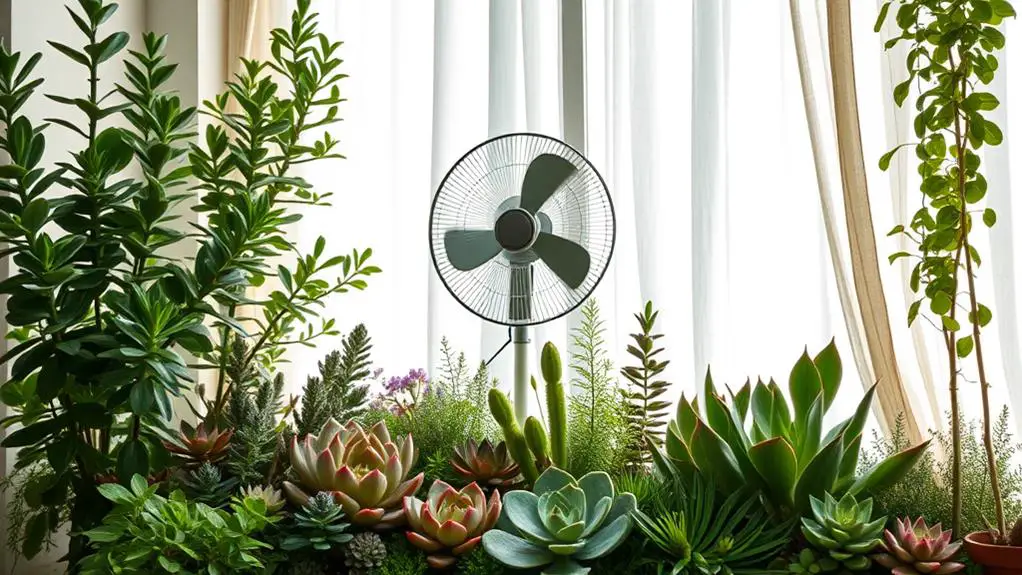
Although managing indoor humidity is essential, enhancing air circulation around your succulents is equally important. By doing so, you can help reduce humidity levels, preventing moisture accumulation that leads to root rot and fungal infections. Using fans or placing your succulents in well-ventilated areas promotes airflow, allowing the soil to dry more quickly after watering.
Ensuring adequate spacing between plants is vital. This allows air to circulate freely, reducing the risk of mold and mildew on the leaves. Regularly cleaning dust off the leaves also promotes photosynthesis and helps maintain lower humidity levels. Improved air circulation can even mitigate temperature fluctuations, keeping your succulents healthy in varying conditions.
Here's a quick guide to enhancing air circulation for your succulents:
| Action | Benefit |
|---|---|
| Use fans or ventilation | Promotes airflow and quicker soil drying |
| Space plants adequately | Prevents mold and mildew |
| Clean dust off leaves | Supports photosynthesis |
| Monitor temperature changes | Mitigates temperature fluctuations |
Adjusting Watering Practices
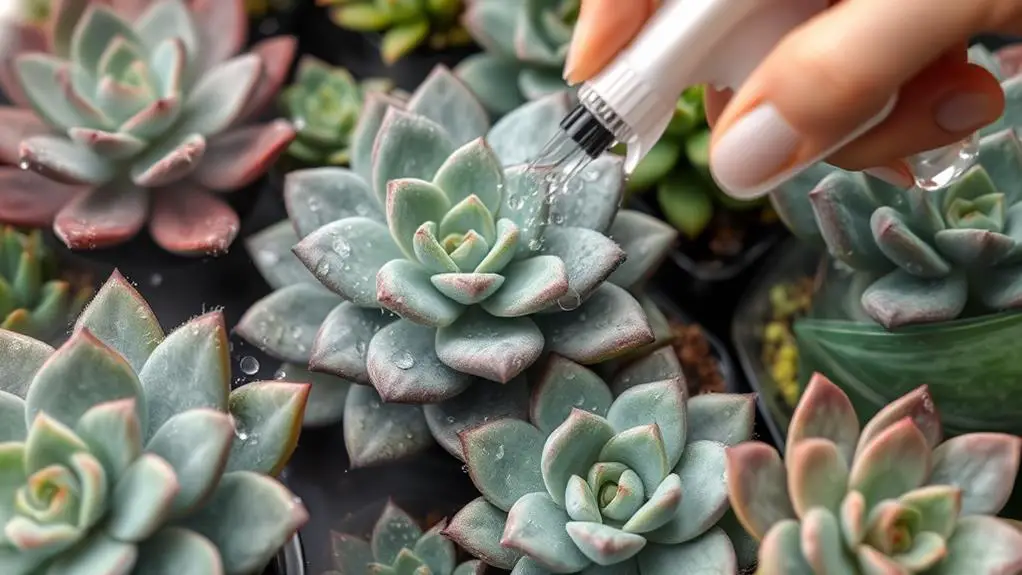
When it comes to adjusting watering practices for your succulents, considering the surrounding humidity is crucial. Properly managing how you water plants can make a significant difference in their health. Here are some key tips to help you:
- Adjust watering frequency: In low humidity, water your succulents every 2-3 weeks. In higher humidity, extend the intervals to prevent oversaturation. This helps avoid overwatering, which can cause root rot.
- Check soil moisture: Before you water, always check the soil. If the top inch is dry, it's time to water. This is especially important in humid conditions where evaporation slows down, making the soil stay wet for longer.
- Use well-draining soil: Succulents thrive in well-draining soil, which facilitates quick moisture evaporation and prevents root rot. Avoid allowing water to pool in saucers or trays beneath the pots, as this can lead to excess moisture that succulents are sensitive to.
Additionally, be mindful of signs of overwatering, such as yellowing leaves or mushy stems. These symptoms can be exacerbated by high humidity, indicating a need to adjust your watering practices accordingly.
Monitoring Soil Moisture
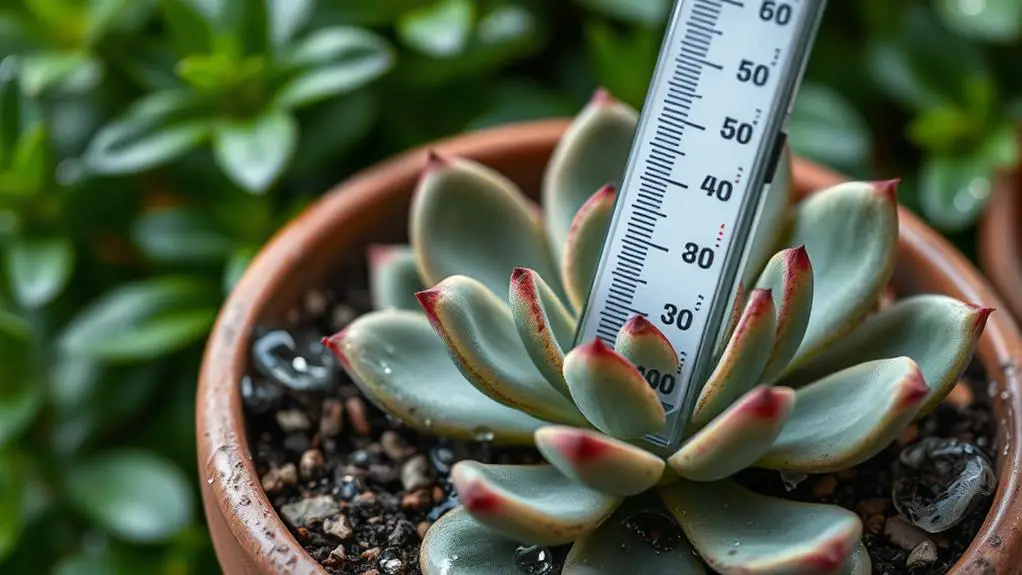
Keeping an eye on soil moisture is vital for the well-being of your succulents. Start by inserting your finger about an inch deep into the soil. If it feels dry, it's time to water. This simple check helps you avoid the common mistake of overwatering, which is critical since succulents store water in their leaves.
For more precise readings, consider using a moisture meter. This tool can give you accurate information about the soil's moisture content and help prevent root rot. After you water your succulent, monitor the soil condition to make sure excess water drains out completely. Proper drainage is essential to avoid moisture stress and root rot.
Adjust your watering frequency based on environmental factors like temperature and humidity levels. In low humidity conditions, you might need to water every 2-3 weeks.
Keep an eye on your succulent's appearance for signs of moisture stress. If the leaves are shriveling, the plant needs more water. If they're yellowing, you're likely overwatering.
Monitoring soil moisture doesn't have to be complicated. By staying observant and using the right tools, you can make sure your succulents thrive. Happy gardening!
Frequently Asked Questions
How Does Humidity Affect Succulents?
Humidity affects succulents by increasing the risk of root rot and fungal infections. They thrive in low humidity, around 40-50%. Monitor soil moisture and guarantee good air circulation to keep your succulents healthy.
Are Humidifiers Good for Succulents?
Humidifiers aren't good for succulents. These plants thrive in low humidity and excessive moisture can lead to root rot and fungal infections. Keep your humidifier in a separate room and monitor humidity levels with a hygrometer.
How Do You Grow Succulents in Humid Climate?
You can grow succulents in a humid climate by choosing humidity-tolerant varieties, using well-draining soil, watering only when the soil is dry, increasing air circulation, and maintaining indoor humidity levels between 40%-50% with dehumidifiers or air conditioning.
Do Succulents Propagate Better in Humidity?
Succulents don't propagate better in high humidity. They thrive in low humidity, around 40% to 50%. Guarantee good airflow and dry soil conditions to avoid rot and fungal infections, enhancing your chances of successful propagation.
Conclusion
By keeping an eye on humidity levels and making sure your succulents have the right conditions, you're setting them up for success. Use a hygrometer to monitor humidity, improve air circulation, and adjust your watering habits to keep the soil from staying too wet. Your succulents will thank you with healthy growth and vibrant colors. With these tips, you're well on your way to becoming a confident succulent gardener. Happy planting!

